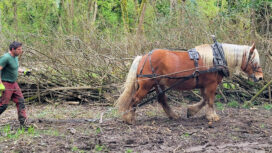Work costing millions is being planned by Wessex Water to dramatically reduce the number of times that sewage is discharged into Swanage Bay after prolonged spells of heavy rain.
The water company is earmarking around £1.4 billion to be spent from 2025 to 2030 on wastewater improvements across its region which includes areas of Dorset including Purbeck, Somerset and Bristol as well as most of Wiltshire and parts of Gloucestershire and Hampshire.

The roof of Swanage sewage works has been built to blend in with the environmentally sensitive Area of Outstanding Natural Beauty
150 Wessex Water outlet pipes to be improved
The exact budget for the next five year period is still being firmed up but it will include the money to reduce storm sewage discharges from 150 Wessex Water outlet pipes, including two in Swanage.
The water company is currently spending £3.5 million a month to reduce the use of overflow pipes but that is set to increase from 2025 to around £9 million a month.
The rest of the wastewater budget is mainly spent on removing the mineral phosphorus from the water at sewage treatment plants before it gets into the sea or rivers.
Phosphorus can boost the growth of plants, blocking water courses and reducing the amount of oxygen in the water for fish and other creatures.

The most used storm overflow in Swanage is at Peveril Point. While storm sewage is untreated, it has to pass through a six millimetre mesh to remove solids before being discharged at this location
Increasingly controversial
It is legal for water companies to use overflow pipes to relieve pressure on sewerage systems during periods of high rainfall, with the aim of preventing sewage from flooding homes. Overflows allow rainwater and diluted sewage (usually screened to remove solids), to bypass sewage treatment works and flow directly into rivers and coastal waters.
While it is allowed, it has become increasingly controversial for the practice to continue, however there are no easy answers as the mainly Victorian drainage system in Swanage was designed to work in that way.
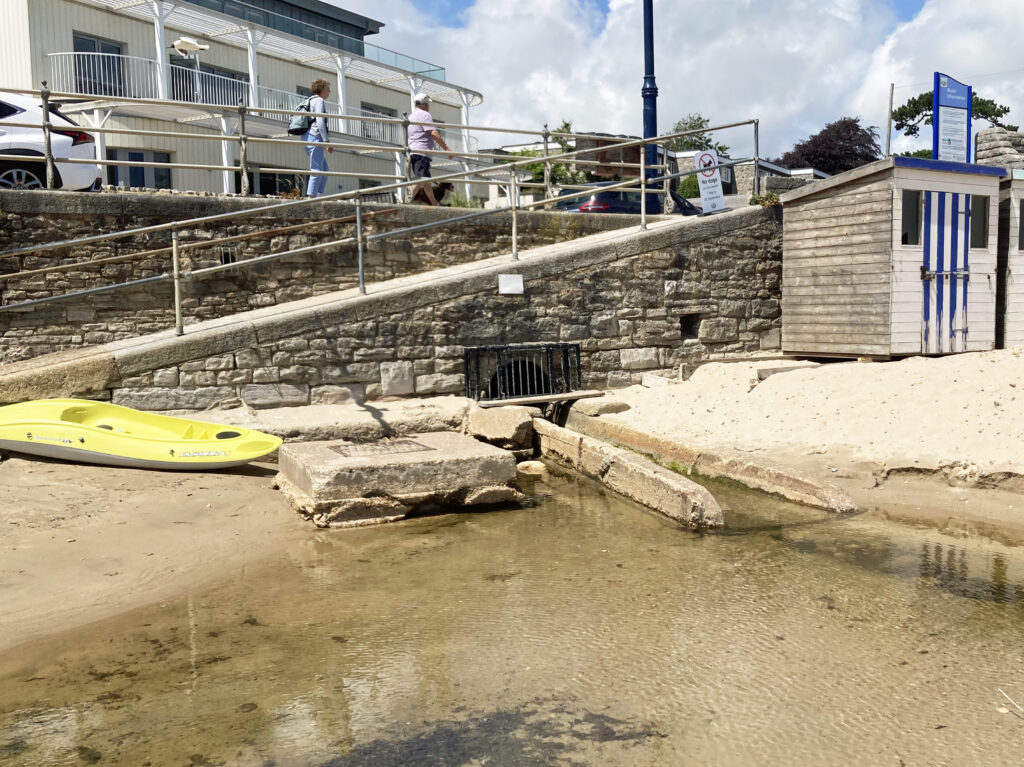
The second most used storm overflow is at Shore Road near Ocean Bay. Normally this is just the point where the Ulwell Stream runs into the sea but after heavy rain, storm sewage may also be discharged through a 10 millimetre mesh
“People have made it clear that they’re not happy”
Andy Mears from Wessex Water said:
“Regular testing by the Environment Agency shows that the bathing water quality in Swanage Bay is consistently excellent. It wasn’t always that way. Before the Swanage sewage works was built in 2000, it was heavily polluted.
“Now the vast majority of Swanage’s sewage goes through a thorough process of filtration to remove bacteria before being discharged as clean water.
“It’s only at times when there’s a lot of rain that the storm sewage bypasses the sewage works and because it is about 99 percent rain water, it’s heavily diluted.
“But people have made it clear that they’re not happy, so more money is being spent to improve the system.”
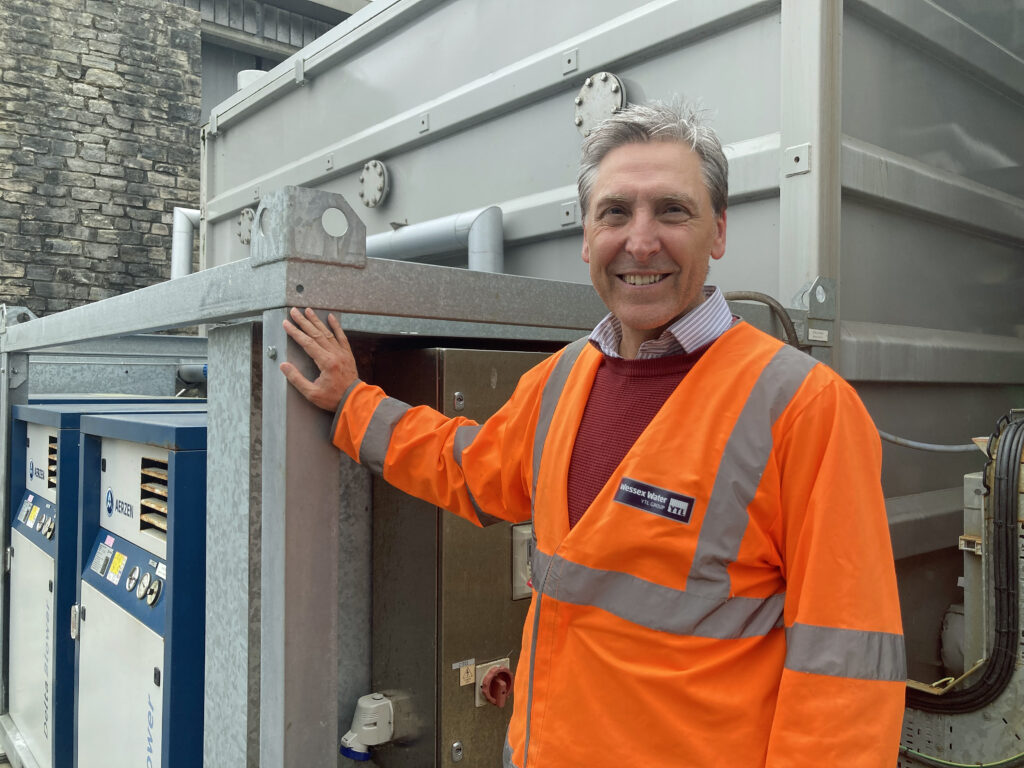
Andy Mears from Wessex Water is keen to point out that due to the lack of rain there have been no storm sewage discharges into Swanage Bay from Tuesday 9th May to Friday 7th July 2023
Number of times Swanage storm sewage overflows used
January to December 2022
- Peveril Point: 15
- Shore Road near Ocean Bay: 12
January to December 2021
- Peveril Point: 19
- Shore Road near Ocean Bay: 10
January to December 2020
- Peveril Point: 29
- Shore Road near Ocean Bay: 7
There is currently a third storm overflow in Swanage in the middle of the bay but it is hardly ever used to discharge storm sewage

Inside the Swanage sewage works built in 2000
Don’t swim for 24 hours after heavy rainfall
New legislation has meant that every time storm sewage overflows into the sea or watercourse it is reported. Campaign group Surfers Against Sewage has created an app that shows where and when sewage has been discharged.
Also Swanage Town Council is alerted when it happens and the staff put out signs along the seafront advising against swimming in the sea.
However it is only legally allowed to happen when there has been heavy rainfall and the rate of flow into the sewage works is so high that the system can’t cope and not allowing it to bypass the treatment works would result in the sewage backing up into people’s homes.
So while the app and the signs are informative, anyone can judge for themselves that it is probably best not to swim in the sea for 24 hours after heavy rain.
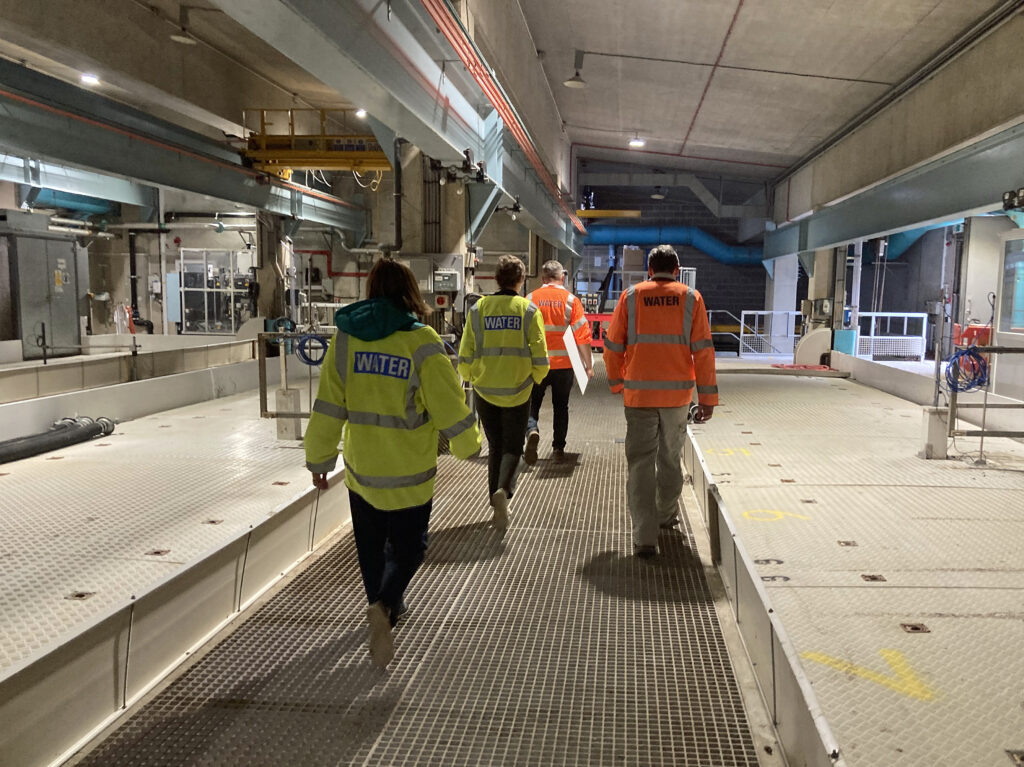
Groups are welcome to book a tour to see the filtration plant – one of Wessex Water’s most technological advanced sewage works
Confusion over types of sewage discharge
There is confusion over sewage discharges, between the diluted storm sewage which is legally allowed and the incidents when raw sewage has been deliberately or accidentally dumped into a water course. Of course, the diluted storm sewage pollutes less than the discharge of raw sewage.
There have been a number of high profile incidents when water companies have illegally allowed a high level of pollution to occur and have been fined by the Environment Agency.
Recently in July 2023, Thames Water was fined £3.3m after it discharged millions of litres of undiluted sewage into two rivers near Gatwick Airport in 2017, killing more than 1,400 fish.
In July 2021, Southern Water was fined £90m after pleading guilty to thousands of illegal discharges of sewage which polluted rivers and coastal waters in Kent, Hampshire and Sussex between 2010 and 2015.

Water recycling manager for Purbeck and Blandford Terry Tester (left) explains that once the solids are separated, the liquid goes into a tank and is passed through filters
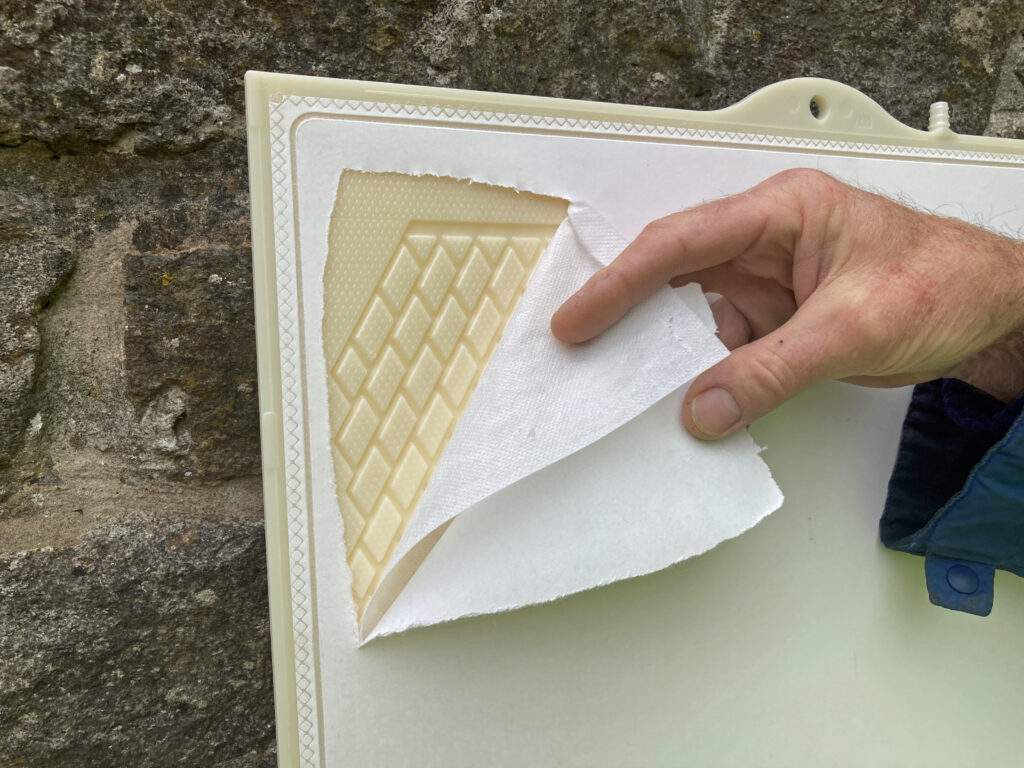
Each tank has 6,000 membranes which are imported from Japan and cost £500,000 to replace per tank
Illegal sewage spills in Swanage
In Swanage, Wessex Water paid out £975,000 in November 2018 after sewage was discharged into the sea during illegal spills in 2016 and 2017.
One of the sewage spills occurred during the 2016 Swanage carnival weekend and another was witnessed by a local RNLI lifeboat crew who complained to Wessex Water and the local authority after sailing through a plume of raw sewage off Peveril Point on 1st August 2016.
At the time, the Environment Agency reported:
“The (Swanage sewage) works had previously operated to a high standard, but its performance deteriorated around the time of the discharges resulting in a loss in storage capacity.
“A storm on 1st August 2016 caused extra flows to enter the works resulting in unconsented discharges into Swanage Bay. The pollution occurred because there was nowhere to store the incoming flows.
“Wessex Water failed to report the discharges until three days later. Swanage Sewage Treatment Works is now operating in compliance with its permit and has been since April 2018.”

The rag – toilet paper and wet wipes etc – are removed first but often wet wipes clog the system and cause delays. Wessex Water says there’s no such thing as a flushable wipe and alternatives should be used
Simplified stages of sewage treatment
On a tour of the Swanage sewage works led by the water recycling manager for Purbeck and Blandford Terry Tester, local residents were shown what happens now to ensure that raw sewage is thoroughly filtered and cleaned before it is allowed to be discharged.
- Rag (toilet paper, wipes etc) is removed from the sewage
- Solids are separated from the liquid
- Sludge is piped to Prospect Farm in Swanage, where tankers take it to be turned into fertiliser for farming
- Liquid is filtered – there are 6,000 membranes per tank
- UV light treatment kills bacteria
- Clean water, said to be good enough to drink, is discharged into the sea
With the increase in the awareness of sewage discharge into the sea, it can seem that the problem is getting worse but in fact, compared to 30 years ago Swanage Bay is much cleaner.
The improvements have been partly driven by the Environment Agency imposing greater transparency on the operations of the water companies.

Remarkably unsmelly, the sewage starts to be filtered
History of Swanage’s wastewater improvements
- Pre-1997: All storm sewage and raw sewage was released via outfall pipes into the sea. It passed through a macerator to reduce the size of any large solids but apart from that, there was no other treatment
- 1997: Stormwater storage tanks were built at Ulwell resulting in a significant reduction in the frequency of spills from combined sewer overflows to the Ulwell Stream.
- 1999: A one kilometre long tunnel was built underground from Swanage Pier to the Main Beach car park. This allowed more storm sewage to be stored, slowing down the flow allowing less to be diverted to the overflows. It also resulted in the removal of a storm overflow at the Swan Brook near The Mowlem.
- 2000: The Swanage sewage works was built by the pier on the site of the demolished Grosvenor Hotel, providing secondary treatment and microfiltration.
- Recent improvements include the installation at Swanage sewage works of UV light process system which kills bacteria in the water

The new UV light process system which kills bacteria in the water
“Exciting programme of works going forward”
Now the next stage is to reduce the use of the overflow pipes at Peveril Point and Shore Road near Ocean Bay.
Andy Mears said:
“It won’t be easy. To design a scheme and construct a solution will take several years. In particular the outflow at Peveril Point, in such an environmentally sensitive location, will be very challenging.
“It’s hard to say exactly what the engineers will want to do but it’s likely to include more storage of water when there’s heavy rain.
“I’m proud of what Wessex Water did in 2000 by building the sewage works in Swanage in the first place, and I’m happy that we’ve got an exciting programme of works going forward.”

The clean, clear water at the end of the filtration process – they say it is good enough to drink!
How to help
Homeowners and businesses can do their bit too by not creating large areas of impermeable hard surfaces like tarmac drives, which increases the speed and flow of the rain water into the drains rather than allowing it to be absorbed into the ground.
Also installing water butts has the same effect as the water company’s storage tanks – reducing the pressure on the sewage works during periods of high rainfall.
Further information
- Bathing water information for Swanage
- More about Wessex Water and storm overflows
- Request a group tour of Swanage sewage works
- Surfers Against Sewage pollution alerts



